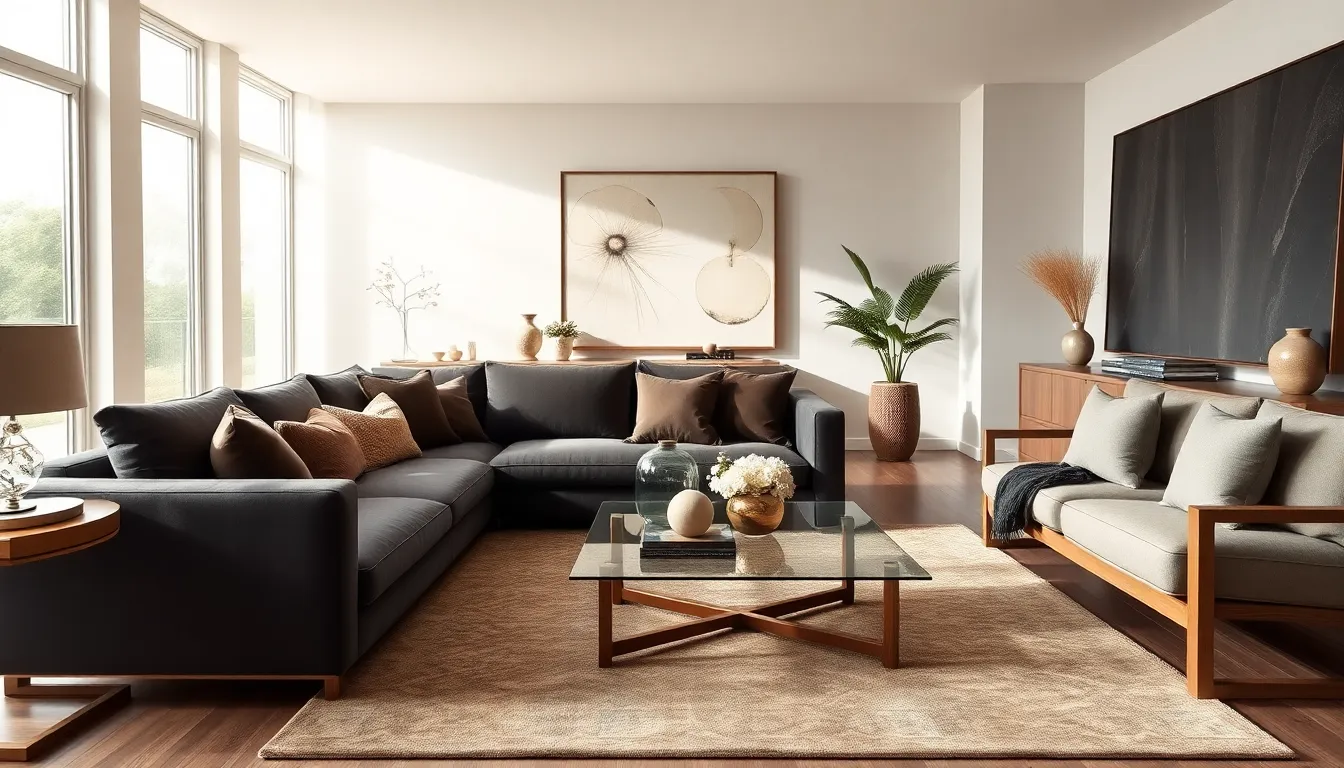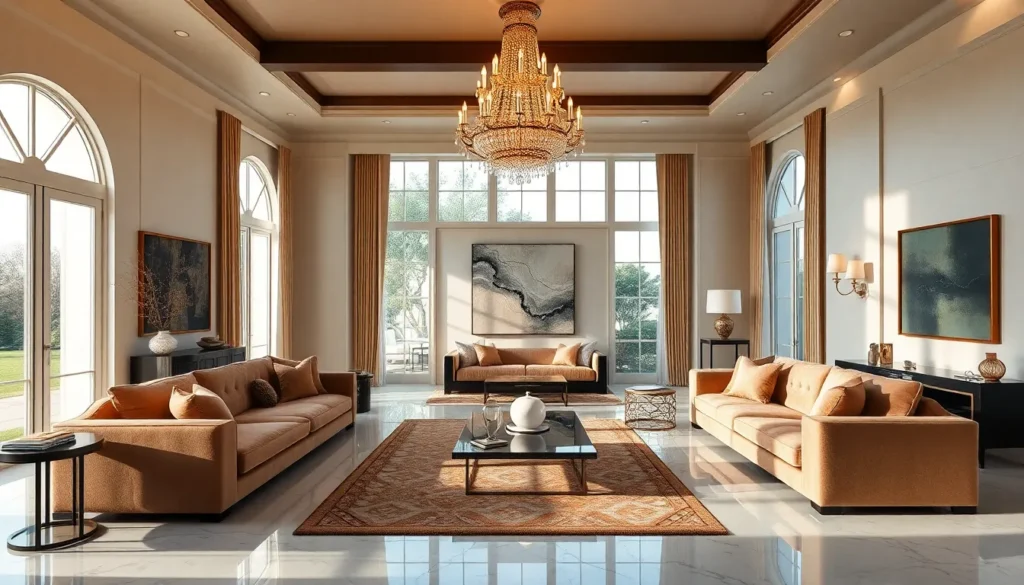Table of Contents
ToggleImagine walking into a home that feels more like a five-star resort, enveloped in comfort and sophistication. Luxury home interiors are not just about opulence: they encompass a space that elevates one’s lifestyle, making every moment feel special. Whether you desire marble countertops or plush rugs underfoot, every choice shapes a sanctuary of exquisite taste. In this guide, we’ll explore the essential elements of luxury home design, unravel various styles, and investigate into the impact of lighting, color, and art, transforming that dream home into reality.
Defining Luxury in Home Interiors

Luxury in home interiors goes beyond superficial glamour. It’s about creating a harmonious blend of comfort, quality, and style. Luxury spaces often reflect personal tastes while ensuring that every detail exudes elegance. This definition varies widely: for some, it might center around oversized furniture and lavish fabrics, whereas for others, it lies in understated design that whispers sophistication rather than shouts it. A luxurious home interior invites tranquility, encourages social interaction, and provides a comforting haven from the outside world.
Key Elements of Luxury Home Design
To achieve luxury home interiors, several key elements must come into play:
- Quality Materials: High-quality finishes such as marble, granite, and exotic woods are crucial. They don’t just look good: they also wear beautifully over time.
- Space Planning: Luxury isn’t cramming in every piece of furniture: it’s about allowing for flow and openness, ensuring that each area serves a purpose while remaining aesthetically pleasing.
- Attention to Detail: Fixtures with intricate designs, custom cabinetry, and specialized millwork add unique character to a space. Even the smallest components, such as doorknobs or light switches, should complement the overall theme.
- Comfort: Luxury spaces encourage relaxation. Plush sofas, thick carpets, and top-notch bedding should beckon one to sink in and stay awhile.
- Personalization: Incorporating elements that reflect personal style is vital. A home should tell the story of those who live within its walls.
Popular Styles for Luxury Interiors
Luxury home interiors come in various styles, each catering to different preferences:
- Modern Elegance: Characterized by clean lines and open spaces, modern elegance embraces simplicity. It often features a neutral color palette paired with striking statement pieces.
- Traditional Opulence: This style celebrates classic decor with rich colors, ornate furnishings, and detailed craftsmanship. Think velvet curtains and grand chandeliers.
- Contemporary Chic: A fusion of comfort and trend, contemporary chic focuses on accessible luxury. This style often utilizes eco-friendly materials and emphasizes open spaces with curated accessories.
- Industrial Glam: Ideal for urban settings, industrial glam marries raw materials with luxurious accents. Think exposed brick paired with sumptuous leather sofas.
Choosing the Right Materials and Finishes
Selecting the right materials and finishes is paramount in luxury home design. These choices should reflect durability and style. When choosing materials:
- Think Sustainability: Opt for sustainable options that score high on aesthetics. Bamboo, reclaimed wood, and recycled glass are excellent choices that marry luxury with eco-consciousness.
- Consider Texture: A mix of textures, smooth marble, warm woods, and soft linens, creates visual interest and depth. Layering different textures can make a space feel richer and more inviting.
- Invest in Timelessness: Certain finishes will never go out of style. Brass and bronze fixtures, for instance, add a touch of classic elegance that pairs well with varied design styles.
Creating a Cohesive Color Palette
A well-curated color palette unifies luxury interiors. When selecting colors, it’s essential to consider:
- Mood: Soft pastels can create a soothing environment, while bold hues may inject energy into a space. Decide the mood you want to evoke and choose accordingly.
- Complementation: Colors should complement each other, ensuring that no shade competes for attention. Consider utilizing a color wheel to find harmonious pairings.
- Neutral Bases: Luxury interiors often start with a neutral base. Shades of white, beige, or gray allow colorful accents and furnishings to shine.
- Accent Colors: Introduce accent colors strategically, whether through accessories, artwork, or feature walls. These pops of color can elevate a space without overwhelming it.
Incorporating Art and Accessories
Art and accessories are the finishing touches that can transform a luxurious home interior. When incorporating these elements:
- Personal Collection: Displaying personal artwork showcases individuality and invites conversation. This could be anything from paintings to sculptures that resonate personally.
- Textiles: Luxurious fabrics like silk, velvet, or cashmere add layers of comfort and sophistication. Throw pillows, blankets, and area rugs should be chosen carefully to enrich the overall aesthetic.
- Statement Pieces: Every luxury interior should feature at least one statement piece, be it an oversized art installation or a unique antique. This creates a focal point that draws the eye and enhances visual interest.
The Importance of Lighting in Luxury Interiors
Lighting often makes or breaks a space. In luxury home interiors, good lighting serves both functional and aesthetic purposes:
- Layered Lighting: Combine ambient, task, and accent lighting to create an inviting and well-lit environment. Each layer serves its purpose, ensuring every corner is well-illuminated.
- Stylish Fixtures: Chandeliers, sconces, and stylish floor lamps should be chosen not only for their function but also for their design. Unique fixtures can serve as works of art themselves.
- Natural Light: Maximizing natural light should be a priority. Large windows, skylights, or even glass walls can enhance the beauty of a room and create a solid connection to the outdoors.





